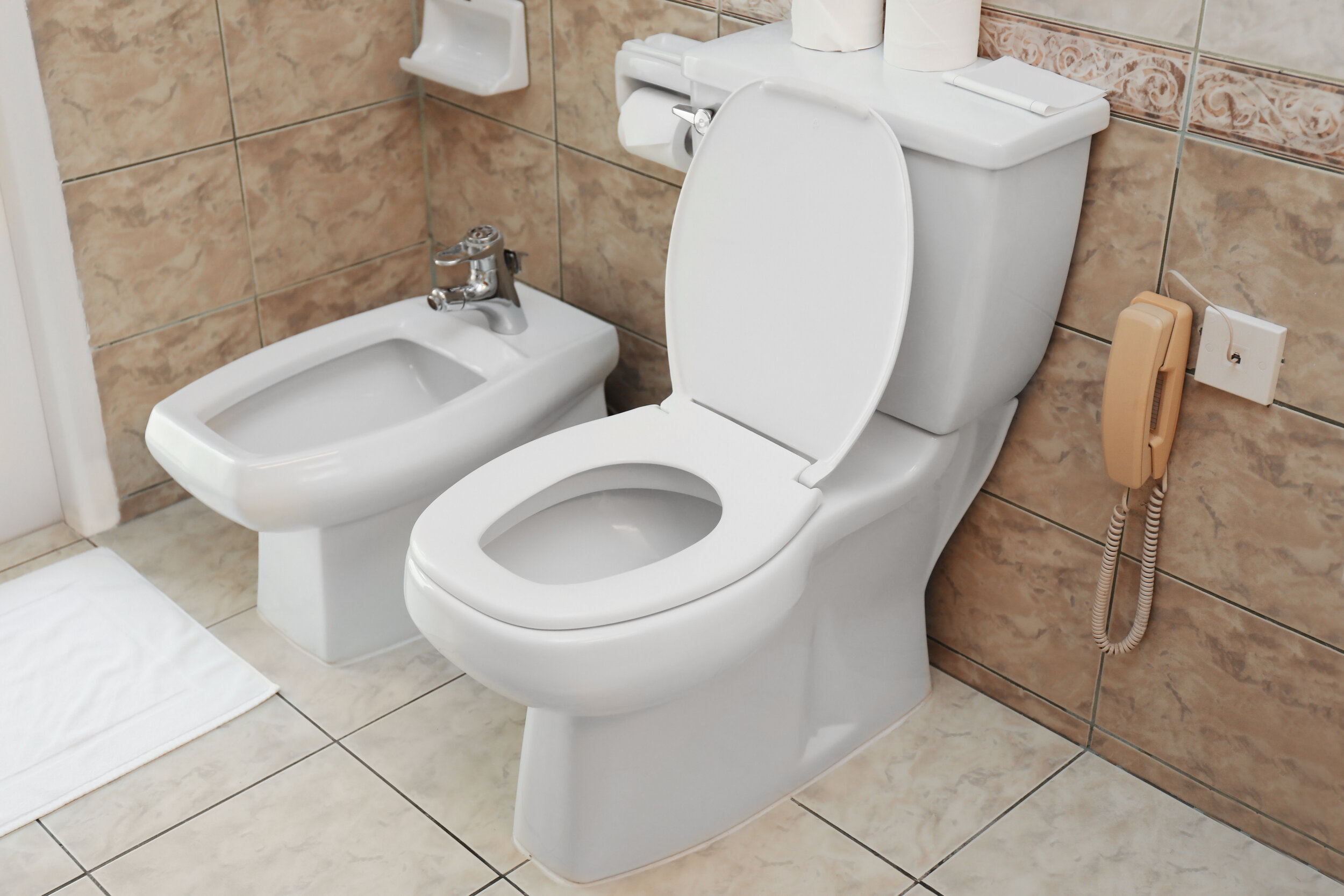The Toilet and Bidet 1-2 Punch: No Toilet Paper, No Problem
Toilet and bidet side by side
Toilet paper is a hot commodity these days—if you can find it. Many stores still haven’t been able to restock their shelves consistently. Eventually, we’ll all be able to buy toilet paper again. But do we really need to?
Perhaps we’ve been deceived into believing that it’s more essential than it actually is. Perhaps it’s time to rethink your toilet paper strategy!
What Is a Bidet?
Bidets are basically water fountains that are designed to clean your nether regions. The classic bidet, which is found in many bathrooms throughout Europe and Asia, is a basin with a nozzle that delivers an upward spray of water toward your posterior as you straddle it.
Bidets came about because people needed to clean themselves after they used their chamber pots. Toilet paper is a newer luxury. It wasn’t widely available commercially until the late 1800s or early 1900s. If people got away without using it 100 years ago, why do we consider it so indispensable today?
There’s no easy answer to that. We’ve become accustomed to using toilet paper, but it’s not the only option. Many people use family cloth, or washcloths that they collect in a wet or dry bag after wiping, and launder regularly. If you wrinkle your nose at that thought, consider that most people did the same with cloth diapers up until the 1970s or 1980s.
Bidets were invented in France in the 1700s. The French felt it was excessive and wasteful to fill an entire bathtub to clean oneself after using the toilet. The bidet was designed as a miniature version of a bathtub that required much less water. Eventually, a pump and sprayer were added so that people didn’t have to scoop up water using their hands.
Types of Bidets
In some European countries, bidets are required to be in any room that includes a toilet. That’s not the case in the U.S., however.
Many people are now realizing that bidets, which were once considered a last resort for many people, are quite a luxury. In fact you don’t have to install a classic, standalone bidet if you want to cleanse yourself with water after using the toilet. Many modern options are convenient, easy to install and simple to use.
All of the options below except for the standalone bidet and smart toilet can be installed by anyone who can read basic instructions. You don’t need to do any major plumbing adjustments to use most of the models that we describe. You simply attach the bidet hose to the water input on the toilet.
The Original Standalone Bidet
A standalone bidet is similar to what you’d find in Europe. It’s a basin that sits near the toilet and sprays water out. It usually has a nozzle that functions as the water source and faucets to adjust the pressure or temperature. It also has its own drain.
Standalone bidets should be installed by a professional. You’ll need to connect yours to a water supply and sewer drain.
Bidet Toilet Attachments
One of the easiest ways to incorporate a bidet into your bathroom today is to purchase a toilet attachment. These add-ons can be installed on most toilets and turn your throne into a combination toilet bidet. They’re relatively affordable and don’t require professional plumbing skills or knowledge.
Bidet toilet attachments are installed beneath the toilet seat but above the rim of the toilet. They typically have a control panel that extends toward the outside of the toilet seat. The nozzles protrude toward the interior of the toilet bowl. The water usually sprays from behind, toward the front of the bowl. Here are some examples of bidet toilet attachments:
Toilet With Built In Bidet
Bidet toilet seats are similar to bidet toilet attachments. They come with their own seat, however, instead of requiring installation beneath your existing toilet seat. They also transform your toilet into a toilet bidet combo.
One of the most popular bidet toilet seats is the Washlet - Toto bidet.
Toilet Spray Bidet
You can purchase a handheld spray bidet that attaches to the water input and hangs next to your toilet. These look like small showerheads. You can use the toilet bidet spray to clean yourself, aiming the spray exactly where you need it to go.
Many parents that put cloth diapers on their children use these sprayers to clean up before they toss the diapers in the laundry.
One of the benefits of a hand held bidet like the Aquaus 360 is that you can take it with you when you travel.
Smart Toilets
Most of them do have bidet functions, making them ideal for cleaning up after you use the lavatory.
Although, to say that a smart toilet is a combined bidet toilet minimizes its complexity and capabilities. Smart toilets can often play music, freshen the air and clean themselves. According to a study by Stanford University, some smart toilets can even detect a range of disease markers in stool and urine. Some of those disease markers could include certain types of cancers like colorectal or urologic cancers.
Benefits to Installing a Bidet
Earth-Friendliness
Toilet paper isn’t very environmentally friendly. It can clog sewers and lead to the elimination of old-growth forests. Using a bidet can reduce your toilet paper usage by 75 percent.
Cost Savings
On average, toilet paper costs about $3 a roll. A family of four that’s confined to their house 24 hours a day would need about 8 rolls of toilet paper per week. That means that a family of four could spend $24 per week on toilet paper. At $1,248 a year, that is much more expensive than installing a bidet.
Depending on the type of bidet that you choose, you would likely shell out between $30 and $600. Some smart toilets are more expensive, but many cost less than $1,500.
One exception is the Kohler Numi 2.0, which has a price tag of $9,000. That smart toilet has spraying and drying options. It also features Bluetooth connectivity, speakers, a touch-screen remote, a heated seat and a foot warmer. If all you need is a bidet, you can certainly find a less expensive option. But even if you purchase this high-end smart toilet, the price will even out in seven years of not buying toilet paper.
Increased Home Value
If you install a standalone bidet or smart toilet in your home, you could increase the resale value of your property. Many homeowners look for upgraded features when they purchase a new home. A fancy toilet might be a great selling point.
Spending several thousand dollars on a bidet or smart toilet might not be worth it, however. Keep the cost of your toilet or bidet commensurate with the value of your home. A $135,000 house with a $9,000 combined bidet toilet doesn’t make much sense. But a bidet toilet seat or washlet could make your home more desirable than the one that’s for sale next door.
Better Health
Studies show that using a bidet reduces the incidence of hemorrhoids and infections below the belt. Cleaning up with water instead of toilet paper can also reduce the risk of irritation and abscesses.
Are There Any Drawbacks to Using a Bidet?
Bidets that use warm water can breed microbes if they’re not disinfected properly. But you can have similar issues with a regular toilet.
If the spray isn’t properly directed, it can soak your clothing. When you purchase a bidet attachment, make sure that the stream doesn’t extend past the front of the toilet seat to avoid this issue.




